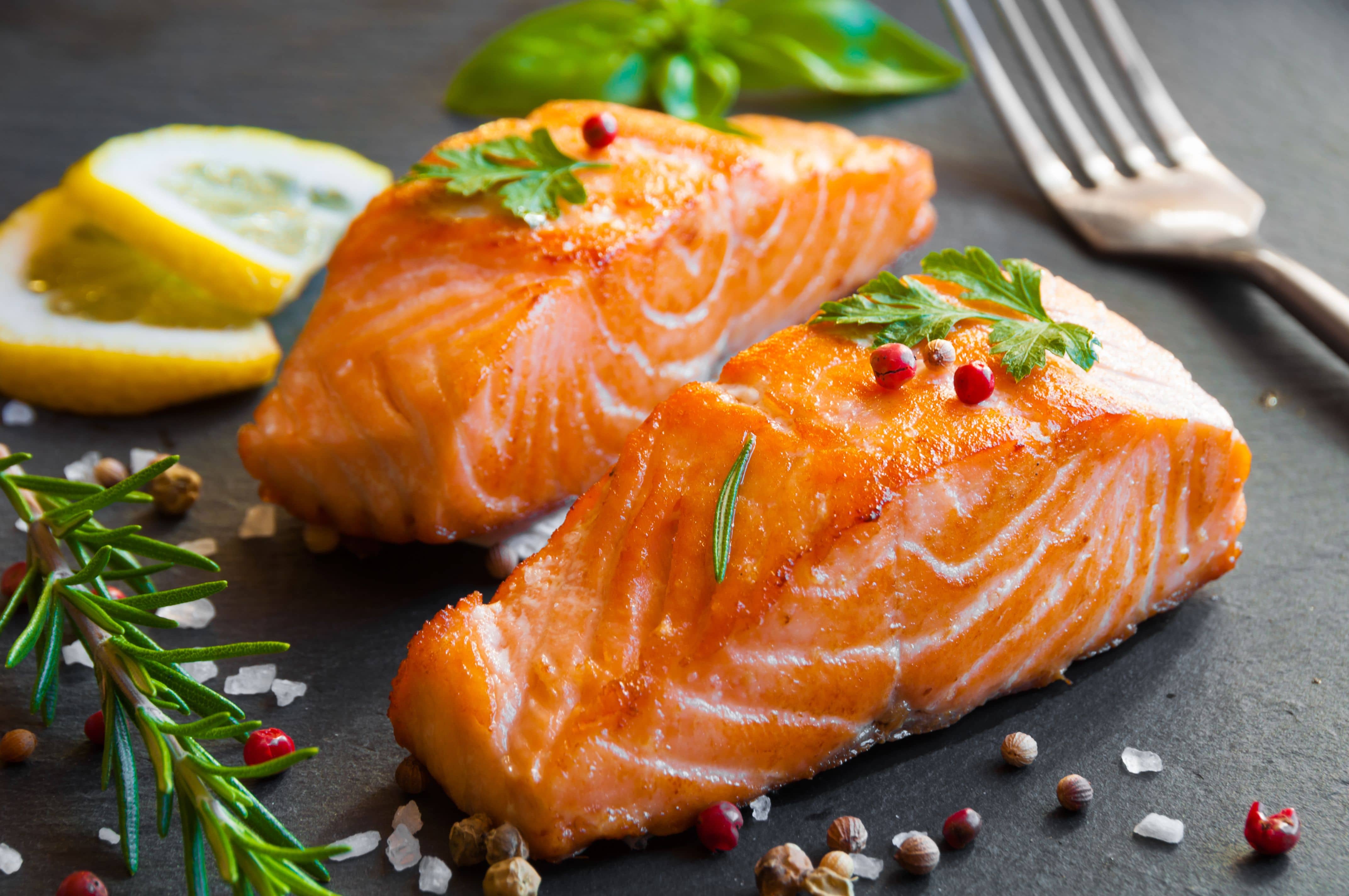
This year we are faced with the specter of no salmon from the North Coast. The Department of Fish and Wildlife is concerned that the spawn rate is dangerously low given the last few years of drought. That doesn’t mean that there won’t be salmon to buy. Just that it probably won’t be coming from our North Coast. Reports are encouraging for salmon supplies from the Northwest and Alaska, however.
Salmon is one of the most delicious and nutritious proteins we can eat. Unfortunately, it often ends up dry and over-cooked especially when grilled. A simple way of cooking it that helps the fish to retain its moisture and oils is to cook at a lower temperature.
It’s a very simple technique and will almost guarantee that melt-in-your-mouth texture that most of us are looking for. When cooking salmon or other oily fish at higher heat for a shorter period of time, the proteins coil up and constrict, causing the oils to secrete, making the fish dry, chewy and chalky. When you cook salmon at a lower temperature, the proteins are coiled more slowly, allowing the fish to retain more of its moisture and oils.
Here’s a simple recipe:
Four 6-ounce skin-on salmon fillets
Kosher salt and freshly ground black pepper
1 lemon cut in 8 wedges
A mixture of a couple of tablespoons of fresh herbs of your choice such as chives, dill and parsley
Preheat the oven to 300 degrees and line baking sheet with parchment paper.
Pat salmon dry with a paper towel and place on baking sheet skin side down.
Sprinkle salt and pepper generously over salmon. Squeeze a wedge or two of lemon over followed by a sprinkle of fresh herbs.
Bake salmon until salmon flakes easily with a fork and is slightly opaque, about 20-25 minutes depending on its thickness. It will look a little undercooked but don’t worry, it’s not.
To remove the skin, carefully slide a thin spatula (now is the time to finally buy a real fish spatula!) between the flesh and the skin, leaving the skin behind. What could be simpler and you’ll be rewarded with one of the best fish fillets you’ve ever eaten.




185 thoughts on “Slow-Cooked Salmon Will Leave You in the Pink”
I dugg some of you post as I thought they were very beneficial handy
wonderful issues altogether, you just received a logo new reader. What might you recommend about your put up that you made a few days in the past? Any sure?
It is truly a great and helpful piece of information. I am satisfied that you shared this useful information with us. Please keep us informed like this. Thank you for sharing.
I?¦ll immediately seize your rss as I can’t find your e-mail subscription hyperlink or newsletter service. Do you have any? Please permit me understand so that I could subscribe. Thanks.
Hello my family member! I wish to say that this post is awesome, great written and include almost all significant infos. I’d like to peer more posts like this .
Very interesting info !Perfect just what I was searching for! "The whole point of getting things done is knowing what to leave undone." by Lady Reading.
There is apparently a lot to identify about this. I believe you made various good points in features also.
I’d have to examine with you here. Which is not one thing I usually do! I take pleasure in reading a post that may make folks think. Additionally, thanks for permitting me to comment!
It is really a nice and helpful piece of information. I’m glad that you shared this useful info with us. Please keep us up to date like this. Thank you for sharing.
Thank you for some other magnificent post. The place else may anyone get that type of info in such a perfect method of writing? I’ve a presentation next week, and I am on the look for such info.
There’s noticeably a bundle to learn about this. I assume you made certain good factors in features also.
It is in reality a great and helpful piece of info. I?¦m satisfied that you shared this useful info with us. Please keep us informed like this. Thank you for sharing.
This is a topic close to my heart cheers, where are your contact details though?
It?¦s truly a nice and useful piece of information. I am glad that you simply shared this helpful information with us. Please stay us informed like this. Thanks for sharing.
Pretty! This was a really wonderful post. Thank you for your provided information.
I truly appreciate this post. I have been looking everywhere for this! Thank goodness I found it on Bing. You have made my day! Thank you again
What i do not realize is actually how you are not actually much more well-liked than you may be right now. You’re very intelligent. You realize thus considerably relating to this subject, produced me personally consider it from so many varied angles. Its like men and women aren’t fascinated unless it is one thing to accomplish with Lady gaga! Your own stuffs outstanding. Always maintain it up!
Hello. splendid job. I did not anticipate this. This is a impressive story. Thanks!
It?¦s really a cool and helpful piece of information. I?¦m happy that you just shared this useful info with us. Please keep us up to date like this. Thanks for sharing.
Thanks for the sensible critique. Me & my neighbor were just preparing to do a little research on this. We got a grab a book from our local library but I think I learned more from this post. I’m very glad to see such excellent info being shared freely out there.
I’d need to verify with you here. Which is not something I normally do! I enjoy studying a post that will make people think. Additionally, thanks for permitting me to comment!
База отдыха в Подмосковье на берегу озера с пляжем – двухэтажный коттедж, баня + бильярдная, купель, бассейн, камин. Лучшие условия и цены. Нас рекомендуют! Снять коттедж на выходные и на месяц +7(916)671-79-58
Hello, you used to write wonderful, but the last several posts have been kinda boring… I miss your super writings. Past several posts are just a little out of track! come on!
Your style is so unique compared to many other people. Thank you for publishing when you have the opportunity,Guess I will just make this bookmarked.2
This actually answered my drawback, thank you!
Hello, you used to write magnificent, but the last several posts have been kinda boring… I miss your great writings. Past several posts are just a bit out of track! come on!
You actually make it seem so easy together with your presentation but I to find this topic to be really one thing which I believe I would by no means understand. It seems too complicated and extremely broad for me. I’m having a look ahead in your next post, I’ll attempt to get the hold of it!
Very nice design and style and good subject matter, nothing at all else we want : D.
Perfectly written subject material, Really enjoyed looking through.
F*ckin’ tremendous issues here. I’m very glad to see your post. Thank you a lot and i am having a look forward to contact you. Will you please drop me a mail?
I couldn’t resist commenting
You could certainly see your expertise within the paintings you write. The world hopes for even more passionate writers like you who aren’t afraid to say how they believe. All the time follow your heart. "We are near waking when we dream we are dreaming." by Friedrich von Hardenberg Novalis.
I do like the way you have framed this specific situation plus it does provide us a lot of fodder for thought. Nevertheless, because of everything that I have witnessed, I just simply trust as the actual reviews pile on that folks continue to be on point and in no way embark upon a soap box of some other news of the day. All the same, thank you for this excellent point and although I do not really go along with this in totality, I respect the perspective.
I will right away grab your rss feed as I can not to find your e-mail subscription hyperlink or e-newsletter service. Do you’ve any? Kindly permit me recognise so that I could subscribe. Thanks.
I really value your piece of work, Great post.